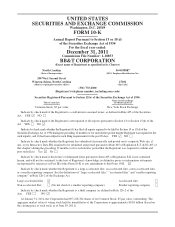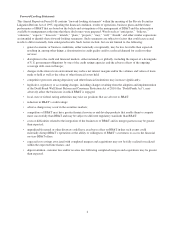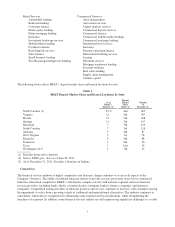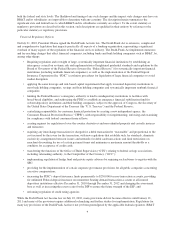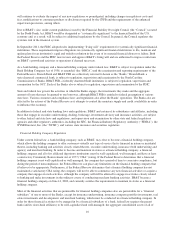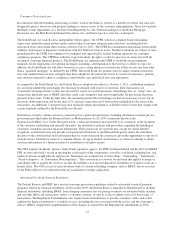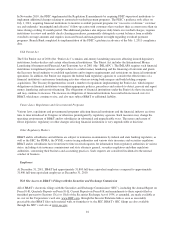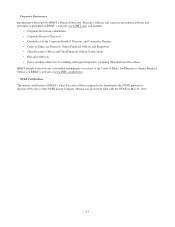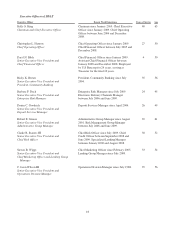BB&T 2011 Annual Report Download - page 8
Download and view the complete annual report
Please find page 8 of the 2011 BB&T annual report below. You can navigate through the pages in the report by either clicking on the pages listed below, or by using the keyword search tool below to find specific information within the annual report.of the economic crisis, resulting in bank and thrift failures. For additional information concerning markets, BB&T’s
competitive position and business strategies, and recent government interventions see “Market Area” and “General
Business Development” below.
Market Area
BB&T’s primary market area for its banking operations consists of North and South Carolina, Virginia, Maryland,
Georgia, eastern Tennessee, West Virginia, Kentucky, Florida, Alabama and Washington, D.C. In addition, BB&T has a
smaller banking presence in Texas and Indiana. The Colonial acquisition facilitated BB&T’s entry into the Texas market.
The markets that BB&T operates in have a diverse employment base and primarily consist of manufacturing, general
services, agricultural, wholesale/retail trade, technology, government and financial services. Management strongly
believes that BB&T’s community bank approach to providing client service is a competitive advantage that strengthens
the Corporation’s ability to effectively provide financial products and services to businesses and individuals in its markets.
Furthermore, BB&T believes its current market area will support growth in assets and deposits in the future.
General Business Development
BB&T is a regional financial holding company. BB&T has maintained a long-term focus on a strategy that includes
expanding and diversifying the BB&T franchise in terms of revenues, profitability and asset size. This strategy has
encompassed both organic growth and acquisitions of complementary banks and financial businesses. During the 1990’s
and through the mid-2000’s, BB&T’s growth resulted largely from mergers and acquisitions as the economics of business
combinations were compelling. Since that time, BB&T has focused more on organic growth, but is well positioned for
strategic opportunities.
Merger and Acquisition Strategy
BB&T’s growth in business, profitability and market share has historically been enhanced by strategic mergers and
acquisitions. Management intends to remain disciplined and focused with regard to future merger and acquisition
opportunities. BB&T will continue to assess bank and thrift acquisitions subject to market conditions, primarily within
BB&T’s existing footprint, and will pursue economically advantageous acquisitions of insurance agencies, specialized
lending businesses, and fee income generating financial services businesses. BB&T’s strategy is currently focused on
meeting the following three acquisition criteria:
• transactions must be strategically attractive – meaning that any bank acquisition should be in BB&T’s existing
footprint to allow for cost savings and economies of scale, or in contiguous states to provide market
diversification;
• any credit-related issues would need to be addressed; and
• acquisitions must meet BB&T’s financial criteria – earnings per share should be accretive in Year 1, excluding
merger-related charges, but including full run rate synergies; the internal rate of return should exceed 15%, and
the transaction should be accretive to tangible book value or have a reasonable earn-back period.
Regulatory Considerations
The following discussion describes elements of an extensive regulatory framework applicable to bank holding companies,
financial holding companies and banks and specific information about BB&T and its subsidiaries. Regulation of banks,
bank holding companies and financial holding companies is intended primarily for the protection of depositors and the
Deposit Insurance Fund (the “DIF”) rather than for the protection of shareholders and creditors. As described in more
detail below, comprehensive reform of the legislative and regulatory landscape occurred with the passage of the
Dodd-Frank Wall Street Reform and Consumer Protection Act (the “Dodd-Frank Act”) in 2010. Implementation of the
Dodd-Frank Act, and rulemaking activities, continued in 2011. In addition to banking laws, regulations and regulatory
agencies, BB&T and its subsidiaries and affiliates are subject to various other laws, regulations, supervision and
examination by other regulatory agencies, all of which directly or indirectly affect the operations and management of
BB&T and its ability to make distributions to shareholders.
BB&T and its subsidiaries’ earnings are affected by general economic conditions, management policies, changes in state
and federal laws and regulations and actions of various regulatory authorities, including those referred to in this section.
Proposals to change the laws and regulations to which BB&T and its subsidiaries are subject are frequently introduced at
8

